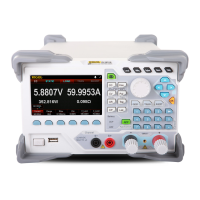RIGOL Chapter 1 Programming Overview
1-4 DL3000 Programming Guide
SCPI Command Overview
SCPI (Standard Commands for Programmable Instruments) is a standardized instrument programming
language that is built upon the existing standard IEEE 488.1 and IEEE 488.2 and conforms to various
standards, such as the floating point operation rule in IEEE 754 standard, ISO 646 7-bit coded character set
for information interchange (equivalent to ASCII programming). This chapter introduces the syntax,
symbols, parameters, and abbreviation rules of the SCPI commands.
Syntax
The SCPI commands provide a hierarchical tree structure, and consist of multiple subsystems. Each
command subsystem consists of one root keyword and one or more sub-keywords. The command line
usually starts with a colon; the keywords are separated by colons, and following the keywords are the
parameter settings available. The keywords of the command and the first parameter is separated by a
space. The command ending with a quotation mark indicates querying a certain function.
For example,
:STATus:QUEStionable:ENABle <enable value>
:STATus:QUEStionable:ENABle?
STATus is the root keyword of the command. QUEStionable and ENABle are the second and third keyword,
respectively. The command line starts with a colon, and different levels of keywords are also separated by
colons. <enable value> indicates a settable parameter. The command keywords
":STATus:QUEStionable:ENABle" and the parameter <enable value> are separated by a space. The
quotation mark (?) indicates querying.
In some commands with multiple parameters, commas are often used to separate these parameters. For
example,
:SYSTem:IDN:SET <manufacturer>,<model>,<sn>,<firmware>
Symbol Description
The following four symbols are not part of the command, and they are not sent with the commands, but
taken as delimiters to better describe the parameters in the command.
1. Braces { }
The contents enclosed in the braces can contain multiple optional parameters. When sending the
command, you must select one of the parameters.
2. Vertical Bar |
The vertical bar is used to separate multiple parameter options. When sending the command, you must
select one of the parameters.
3. Square Brackets [ ]
The contents (keywords or parameters) in the square brackets can be omitted. If the parameter is
omitted, it will be set to the default. For example, when sending the :MEASure[:VOLTage][:DC]?
command, you can select any one of the following four commands, as they can achieve the same
effects as the :MEASure[:VOLTage][:DC]? command.
:MEASure?
:MEASure:DC?
:MEASure:VOLTage?
:MEASure:VOLTage:DC?
4. Angle Brackets < >
The parameter enclosed in the angle brackets must be replaced by an effective value. For example,
the :LIC:SET <sn> command must be sent in the form of :LIC:SET
UVF2L3N3XXKYTB73PPRSA4XDMSRT.

